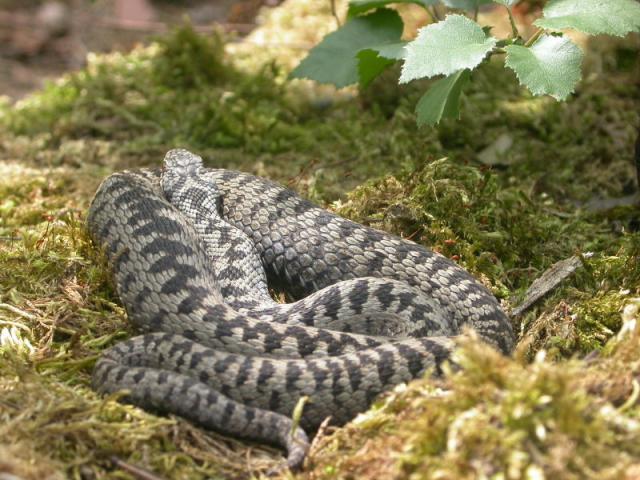Taxonomic classification:
Kingdom: Animal (Animalia)
Phylum: Gerinchúrosok (classification Kingdom)
Sub phylum: Vertebrates (Vertebrate)
Class: Reptiles (Reptilia)
Order: Scaly reptiles (Squamata)
Subsystems: Snakes (SERPENTES)
Family: Vipers (Viperidae)
Subfamilies: Azemiopinae
Causinae
Crotalinae
Viperinae
Distribution and habitat:
In Europe, only the genus Vipera "real " vipers live. Seven species of the group of ten belong to the European reptile fauna, but among them only the generally-known Crusaders (Vipera berus) occur in larger areas of our continent. It is also the one rising up farthest north areas. (The area stretches from England to the Szachalin)island.
In Hungary, two viper species exist: rákosi viper (Vipera ursinii rakosiensis)
keresztes viper (Vipera berus)
They occurred mainly in scrub parts of forests, , opening of the wall, clearing of forests and their surroundings with bushes, rocky hills covered by small trees.
The rákosi viper is inhabitant of steppe stains. Its present stocks have remain in variety of micro-relief of wet and dry grasslands where the microclimate provide them with a rich variety of habitat for prey.
Morphology, structure:
For most members of The Viperinae Crotalinae subfamilies have the bulky, relatively large, sometimes almost awkward torso, broad and flat, triangular head and short nose and short tail (however males always have longer ones than that of females).
For almost all viper species vertical position of pupils is typical, as they search for food in the evening and twilight.
These snakes have highly developed poison appliance. The strongly shortened upper jaws big hole tubular fang curves inwards. The sting of the mucous membrane of the mouth is closed like bag located in the crease.
The venom of two large temples in the area of the gland is formed. These glands were transformed into salivary gland. A special poison fermentums the composition of the tissue mill near the heavily swollen and discolored, swollen lymph glands in the bitten part becomes very painful, the feeling is worsening (dizziness, nausea, chills from a drop in body temperature, blood pressure reduction, etc.. )
Nutrition:
They mainly feeds on (mice, gopher, smaller rats) rodents, but not ruling out the frogs, lizards, birds. They usually bite the target prey, and the they swallow it.just when it has been killed by the poison,
Habits:
The species has reclusive lifestyle particularly when it is extremely hot, it is very vigilant, and able to detect the approaching person from a great distance. In case of danger it always tries to escape first, but in case o fan accidental step on or touch, it defends fiercely accompanied by very loud blowing noise, and as a last chance, bites the attacker with lightning-fast motion, which is very often only the first so-called sham bite, as it does not bite the offenders, only after repeated milling. In many cases, during the sham bite it does not inject the poison.
During the winter time they hide in roden tubes inside upper part of hills to survive the winter col din hibernated state. After the winter hibernation they appear at the end of February and March, at first they do not move a lot, and bask a lot.
Reproduction:.
The majority of vipers is viviparous. After their birth the fang of small vipers functional immediately.The 12-16 cm long offsprings bear their parents’s patterns, and they moult soon.The first moult of the first year will be held on a monthly basis, then as their growth slows it becomes less frequent.
Role in the ecosystem:
Small mammals, vertebrates (eg rats, mice etc) belong to the main source of food of the vipers and thusthey have an important role in keeping rodent populations at the numbers.
Vulnerability:
In our country crusader vipers are rare.They occur mainly in Somogy and Zala counties, Tokaj-hill and its surroundings. They include some hundreds ones only. The number of individuals of the species due to their hidden lifestyle is little-known. Among the natural enemies we can find hedgehogs and feral fall, but the young vipers are consumed by almost all kinds of animals (larger birds, moles, etc). The main reasons of theiir habitat loss are fragmentation, total isolation, intensive wildlife and human impacts. The conservation value of the species is 50.000 Ft
The rákosi viper is the only native vertebrate species. The loss of habitats threatens them most seriously. The present current stock does not cover extensive areas of the Danube and Tisza rivers either. There is no interoperability between each of the habitats, the large and small populations are isolated from each other.
In 2004, MME and Reptile Protection Amphibious Division launched a program in the framework of the European Union LIFE-Nature support to ensure long-term survivalof the species. The aim of the program is to ensure the stabilization of the number and situation of the species by appropriate management plans and habitat restoration interventions
Conservation value: HUF 1,000,000
Kurt Deckert – Állatvilág – Halak, Kétéltűek, Hüllők, Urania könyvkiadó
Jiri Felix – Kígyók, Mezőgazdasági könyvkiadó
